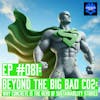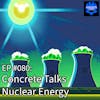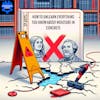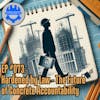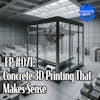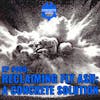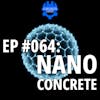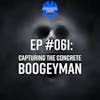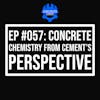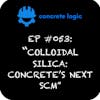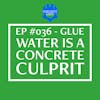EP #083: Laser Scanning’s Role in Concrete Construction
In this episode, Seth interviews Leo Zhang, a virtual construction manager and chair of ACI 117 subcommittee 117 L, who discusses using laser scanning in concrete construction. He explains that laser scanning is a form of reality capture that uses an optical instrument to collect dimensional information and create a 3D point cloud model.
Laser scanning is used in various stages of construction, including pre-construction planning, quality assurance, and as-built documentation. While laser scanning has many benefits, such as detecting clashes and ensuring accuracy, there are still limitations and challenges to overcome. Overall, laser scanning is a valuable tool that complements other surveying methods in the construction industry.
Takeaways
- Laser scanning is a form of reality capture that uses an optical instrument to collect dimensional information and create a 3D point cloud model.
- Laser scanning is used in various stages of construction, including pre-construction planning, quality assurance, and as-built documentation.
- Laser scanning can help detect clashes, ensure accuracy, and improve efficiency in construction projects.
- While laser scanning has many benefits, there are still limitations and challenges to overcome, such as accuracy and standardization.
Chapters
00:00 Introduction and Podcast Support
03:37 Overview of BIM and Laser Scanning
08:08 Challenges in Detailing Models for Concrete Structures
09:37 Application of Laser Scanning in Construction
15:54 Pre-Pour Quality Assurance with Laser Scanning
22:22 Favorite Use of Laser Scanning on a Job
25:09 Limitations and Certification of Laser Scanning
28:21 Setting Standards and Certification for Laser Scanning
31:07 Conclusion and Contact Information
***
Did you learn something from this episode? If so, please consider donating to the show to help us continue to provide high-quality content for the concrete industry.
Donate here: https://www.concretelogicpodcast.com/support/
***
Episode References
Guest: Leo Zhang | The Conco Companies | lzhang@conconow.com
Guest Website: https://www.conconow.com/
Producers: Jodi Tandett
Donate & Become a Producer: https://www.concretelogicpodcast.com/support/
Music: Mike Dunton | https://www.mikeduntonmusic.com | mikeduntonmusic@gmail.com | Instagram @Mike_Dunton
Host: Seth Tandett, seth@concretelogicpodcast.com
Host LinkedIn: https://www.linkedin.com/in/seth-tandett/
Website: https://www.concretelogicpodcast.com/
LinkedIn: https://www.linkedin.com/company/concrete-logic-podcast
[00:00:00] Seth: Welcome to another episode of the Concrete Logic Podcast. And today I have Leo Zhang with the Conco Companies. He is a virtual construction manager in San Francisco, and he is a ACI committee. He's on the ACI committee 131, which is building information modeling of concrete structures. And he's also on the.
He is the chair of ACI 117 subcommittee 117 L, which is laser scanning. And he just got back from the AC ACI convention. So we hit him up on a good time. So he's all excited to talk to me about laser scanning. But before we get started, I'm just going to remind you everyone that listens to the podcast is.
This is a value for value podcast, meaning I do my best to provide you a value each episode. So I, if you learn something from Leo today you can support the podcast in three different ways. And the first way is pretty easy is if you like. What you hear from Leo and want to share with a colleague or a coworker.
That's an easy value you can provide back for the podcast. So share the podcast. The second thing you can do is you go to ConcreteLogicPodcast.com and You can contact me a couple of ways. There's a contact button on there, and there's also a little microphone in the bottom right hand side. So if you hit the contact button, it shoots me an email.
If you hit the little microphone, it actually records a voicemail. And then what I'm looking for from you is a topic or a guest suggestion. And just like Leo today was a suggestion from a listener. So I reached out to Leota and bring him on because he's an expert on laser scanning. So that's easy too.
That's the second way. And the third way is you can donate to the show. And you're like, why would I want to donate to the show? You would you want to donate to the show because you want to support the podcast so we can pay for the things that we use to make the podcast. Podcast isn't free. You, we use software, hardware, all kinds of stuff, and then editing and all that good stuff.
So the donations go towards that. And the reason why we ask for donations versus getting sponsors, because me personally, I do not like listening to podcasts and hearing advertisements, nor do I want someone, that. Advertisers on our show and gets upset because I talked to Leo, maybe Leo doesn't have did something to somebody and they don't like Leo.
And they say, hey, why do you have Leo on the show? So this way, we don't deal with it. It's a listener supported podcast. So we can talk to and whoever we want and talk about whatever we want on the podcast. So that's the reason why we do that model. Okay. With that, Leo, thank you for coming on the show.
Like I s I shared with you guys, Leo he is he's the virtual construction manager for the Conco companies. And today I wanted to bring him on cause he's an expert on BIM and laser scanning. Leo, to start us off, could you just give us an overview on what BIM is and what laser scanning is?
,
[00:03:25] Leo Zhang: good morning. Thanks for having me. . So in general, what Ben means is building information modeling. So it's use a 3D model, but doesn't stop with the geometry of the model. It has information in the model, including. You know, material types and construction information sequencing.
Now, those information with within the life cycle of the model for the construction. So it's another term of talking about a BIM people talk about. Virtual design construction, which is VDC. Some people call it digital twin, virtual construction. There's a lot of like buzzword, but they all come handy with, you have a model, you have information in the model, and you use that for.
Construction management in digital layout and all that for construction projects. So that's an easy, my, my interpretation of what BIM means for construction. And laser scanning is some of the organizations, laser scanning is part of the VTC operation. What laser scanning is. You capture with the optical instrument to collect all the dimensional information, and some of them be part of the VDC operation is because it is like a model.
And the other side is a survey tool as well. We're going to talk about more details about laser scanning, but for now, , we'll talk about BIM. That's what I feel like it is.
[00:05:02] Seth: Okay, , like I was sharing with Leo, I'd be hard pressed to run across a project these days that doesn't require some kind of BIM requirement.
It seems to be in every contract or specification. For a job that we run across so essentially it, when I got started in construction, there was nothing like them. There was no modeling or laser scanning everything. It was on drawings. Everybody used hard drawings. I don't even think we use PDFs back then, but .
When This this the BIM for me and the laser scanning, it just makes it so much easier to see what you're dealing with versus when you looked at drawing or a plan, you got to for guys that have been around the business for a long time, you can kind you can vision the, the building in a 3d three dimensions, but the modeling now, man, it's amazing what you see now, and you can really see things and it's, it just makes it so much easier, but did you want
[00:06:03] Leo Zhang: to add to that?
. When we talk about BIM, I basically from a contractor's perspective, we talk about how to use that. It all starts from the design phase. The architect, the engineers they design, and now they use more and more 3d like Revit, Techland, and all that. So they design in that platform.
And then we, cause ACA 131 BIM committee, we developing some document. It's not published yet, but it's IFC exchange. So that's a industry standard format to exchange the information through different platform. So we have, it's got an EM 15, the M six, which is focused on the rebar. And EM20 is for construction sequencing.
So that there's basically you transferring the information, not only the geometry of a cool model in 3d now, so there's information in there, like rebar coverage, rebar size, the steel type in the model itself, ideally, if we have a fully divided process.
[00:07:13] Seth: Do you, are you finding that you're a concrete contractor too?
Are you finding like all the vendors and the subtrades that you work with, are they on board with. Detailing models down to that point, like the rebar and post tensioning.
, that's a good, I think a lot of those come also comes with cost effective and , that's when it does decide if there's a need for a fancy 3d, especially rebar or PD cable model, that's a big factor going to kick in.
[00:07:45] Leo Zhang: But it just may be a dream if we, from the designer side, they design all those information in that platform with all the information embedded and then pass to a subtree like us. We can, if we are a detailer, just going to grab that information right away. And then we set for fabrication as a, it's a dream.
Hopefully going to come true.
[00:08:07] Seth: , I guess the question that comes to my head is, are we going to build off of that? . Meaning I can, I understand like clash detection, where you're trying to find where things are hitting each other before you get out in the field and you actually install them.
But do you see a point where we're actually bringing the model out to the field to say, install rebar or install post tensioning? Do
[00:08:32] Leo Zhang: you see that? It's pretty good visualization tool, be proactive and see that clash ahead. . We have a project recently, there's a couple of lift core wall after the concrete slab casting place, and another five lift on top, and those core wall has the 600 pound embed on the boundaries, and those big, with the big stud, and pretty congested rebar on the boundary.
So I think we had a not a full model, but just focus on one area and show that potential clashes between the embed and bar. That helps. .
[00:09:13] Seth: . No, I definitely see that. It w we use it that way as well as the embeds are a big part of that. But as far as, right now we.
The rebar installer, he has a shop drawing that he goes out and looks at it. And then he, and he installs rebar per that shop drawing. I guess my question is, do you ever see a rebar installer actually? Taking like the model and using it out in the field. That's the part that I have a hard time imagining.
[00:09:46] Leo Zhang: . Me personally, I haven't, I had a, some new startup company. They came to show us some cool VR goggle. We can project the bar, the 3d bars location wise on the field. So you can, the rebar for me, they can see the part in the space. And to, lay it out, but it's just a prototype.
Like I heard there's some projects, there's a. Aquarium job in, in Seattle and to curve, the shape and all those bars, they have a pretty good divided been modeled for that job. But in terms of the field to use it directly. I haven't, at least my personal experience, I haven't seen.
[00:10:32] Seth: So that's more like augmented reality, right? What you're talking about, where you're augmenting what's out in the field, using those goggles. I know what you're talking about. I put them on too.
[00:10:43] Leo Zhang: . It looks pretty cool. And. It worked, but until the technology is stable enough, so they don't have to deal with the hassle of repositioning and now deal with that it stuff.
.
[00:10:54] Seth: . To get a guy. I met somebody at a conference. They did augment augmented reality, their company that just does that. And, uh, I see potential in that maybe not necessarily maybe down the road, Pete or a rebar, but I really see it using it as for form work. So You can see where the form work should go.
I think that's a, I think that has a real potential. The, but since you're on a subcommittee for laser scanning, I know you're passionate about laser scanning. So let's talk a little bit more about laser scanning and where, how it's being used what. I guess we could talk a little bit how it interfaces with BIM, but can you talk a little bit more about laser scanning, about what you're using it
[00:11:42] Leo Zhang: for?
, laser scanning has been around a few decades and recently, With more hardware, software development, more and get lighter, cheaper and easier to use. I think a lot of business like start looking into this solution and it covers not only the construction is some people call it reality.
[00:12:01] Leo Zhang: Capture is part of the reality capture and it can be used on multiple different industries. But we talk about construction, especially concrete construction. And. It can be used first, if people don't know what laser scanning is. It's going to be a long I keep it short. It just it's an instrument is survey instrument set up on a tripod or a different type, but is emitting the lasers and collecting the distance information to the scan.
Scanner precision and basically collect the 3d information and generate a result is called a point cloud. So that point cloud is basically some manufacturer can measure millions of points per second. So it's basically mapping the whole real world. That's why it called reality capture. Some people call it that way.
So with that being said during the pre construction phase, people can. Just scanned the whole site and you can see all the defensing the power line. If there's a concern on the power line to closer to the concrete slab edge. So you tie that whole scan to a survey control, which is so it's still referenced.
So you can see. Some problem I had for example, we scan leggings and there are some jobs we found part of the leggings is intruding into out of the property line. So there's a problem. And so another use of that for pre construction, you can use for, planning the track route your site logistics.
Because you can have a basically a real world one to one 3d model to take any measurement that you want to check instead of, have your safety guy go to the field and measure, and they can't measure to the power line distance, just have to eyeball it or reference somehow. So that's a pretty, pretty good to use for a pre count.
[00:13:58] Seth: Are you using drones for the, like the site example that you gave? Are you using a drone for flies over this, over the top? Or are you setting up a tripod? How are you doing that capture?
[00:14:11] Leo Zhang: It can be done either way. It depends on how accurate you want to measure, right? Is there's a lot of talking about, if we only talk about laser scan is about the LIDAR, but there's other solutions like photogrammetry, like if you use drone, one you can use the camera on the drone for photogrammetry, if your tolerance is not that tight, or you have, there's drones with LIDAR sensor you can, basically it's the same.
Sensor is shooting the lasers and do the measurement. And there's mobile scanner that you can is handheld. You just walk around with it or just, put on a backpack. I'm sure you've seen those people just walking around with monitoring and tripod based that's the one me personally use most of the time.
Cause I feel like the terrestrial scanner stationary and tied to the controller is pretty, pretty accurate that way. But technology is involving, never know the drone, LiDAR or mobile scanning, how accurate you can get. It probably surprised sometimes is as close as the terrestrial scanning.
[00:15:22] Seth: . Is the how fast is this information that you're scanning? How fast can you see it? Is it instantaneous out in the field? Or do you have to gather the information, take it back with you and then put it in a model? Or what's that process?
[00:15:37] Leo Zhang: It's a great question. And again, it depends on what is what hardware used.
So if a lot of a drone after you fly with a camera sensor, those pictures, photos can be uploaded to the cloud, even just right away through the phone with the Wi Fi connection. In those case, and other mobile scanning solution You can basically do it live and upload to the cloud and cloud processing, then give you the result.
Some of them in a few hours, maybe some in a few days. The other workflow that we divide up is using the terrestrial scanner. You have to set up and then do this called a registration to stitch all the setups together. And tied to the survey control points. So there's a procedure.
If you also depends on how accurate you want to achieve. So the more time I'm going to take, if you need a more accuracy, I'll say. And you need to tie to the survey controls, but in general, from anywhere, a couple of hours to, a day to some solution going to take maybe 2 or 3 days to give you the data back.
[00:16:48] Seth: ,
So you go out there, you scan it and then depending on how accurate you need it it'll take, a couple of hours. Are you using it? Are you using your laser scanning for when you're actually pouring concrete yet? Like when it's still wet, are you using it for that? ,
[00:17:08] Leo Zhang: there's well before that is also another good tool for quality assurance.
Like for example, a couple of days before report slab, all the form works in, all the embeds installed and because the natural of laser scanning is you can visualize anything you can see in the scan, right? So people do a scan on the deck, just, 20, 30 setups or even more depends on how much details want to capture.
You can see those edge forms. Any form work and that so depends on line of set as long as you can see them clearly in the skin and they do reference to the, great line and benchmark you can overlay to the, that's the Combination between BIM. You can throw the BIM model into that same scan and anything that's deviated, you can basically do the quality assurance check before the port and fix it before it happens.
So that's a pretty good tool to avoid any rework or repair. And then like, when you ask about the live pour, I think you talk about just scan on the pour day with the finishers to, to give them the feedback of high, low spot before dry. . That's something it can be done with a scanner. A lot of, I know a lot of contractors doing it.
And as long as there's a resource, you have. You have the crew that can is capable of doing that. And I'm sure, and we just did a task a couple of weeks ago on our job is in Berkeley is at a bit of slab. It's pretty small, 5, 000 square feet. So we scan, around 10, 10 o'clock, two, three hours after the report starts and found some hump, like five ways, half inch high.
And we tell the finisher, just go back and where to re-strike it. And then we recheck it. It works. So eventually that's a pretty, pretty good floor that we turn. We turn over there. . It is time consuming just going to be the resource, your operator, the scanner going to be on that side for the whole day.
[00:19:23] Seth: .
But , like you mentioned earlier, you got to find a balance on the costs and the is it worth the cost having that
[00:19:31] Leo Zhang: It doesn't matter how much kind of grind or deal with, the client on the floor being not flat compared to you spent eight, 10 hours on the, On a poor day, I think it's worth it.
[00:19:44] Seth: So what's your favorite use of laser scanning on a job?
[00:19:49] Leo Zhang: My favorite thing is the pre pour. We call it pre pour as field or pre pour quality assurance. So basically you being proactive and avoid any mistake. And every time, there's nothing perfect. Even you have a street slab edge and your crew snapped the line from one end to the other.
And maybe one point in the middle and the line knots, tension, and then your form, which is about work, even the airplane is not plumbed and you can easily see your form is out of half inch or three quarters sometimes. So those information, as long as it's done in time, is very valuable to, as a concrete contractor or, contractor that does self performance.
It helps to avoid any mistake. And we've been caught a lot of, opening sides that change from drawing because you use the drawing from the designer and then. We'll see this different and then you call your foreman there and they said, Oh, they give us a new drawing the day before the poor and we just change the size.
Now, that in reality captured and at least, there's information missing in between or there's whatever kind of conversation needs to be. We know how it looks. If you don't have a visualization tool, then how are you going to, you count down the commenters, just check around and hopefully they can cover all of this stuff.
There's not as easy as you just do a whole scan and can see everything.
[00:21:25] Seth: Do you find that the laser scanning is, can be overwhelming as far as the amount of information that you gather from it? How do you balance that?
[00:21:34] Leo Zhang: I think to that point, in terms of overwhelming, if, some company just, got the sales page and there's a pretty good scanner, fast, and just buy the machine and didn't have a right crew to be trained or, excel on using that, those type, those organizations may be overwhelming to see.
Struggling with it, but I would say if you have a champion with your own company that loves it and get trained for it, the information is not really that overwhelming.
[00:22:08] Seth: . Are there any limitations that you ran across so far that you hope that laser scanning will accomplish it at some point?
[00:22:17] Leo Zhang: I've been testing different solution, talk about a mobile scanning. You can just head held and walk and do the fast or like you mentioned use drone to scan it. Hopefully they can be in the range of accuracy as when we talk about a the concrete tolerance. The measurement needs to be no more than a third of the concrete tolerance.
So let's say If we measure the slab edge, which is plus or minus one inch tolerance per the ACI 117, our measurement accuracy needs to be less than a third of an inch. Give and take about a quarter inch. And so that's why there's no study showing, even though the sales page, they say, oh, my mobile scanner or digital can achieve that is still not proven that it can be that accurate.
But the limitation was. The faster you can collect the data and do the analysis faster, the field can have more time to take action, to, if they need to move anything, they can't wait until the poor day to do it. So I would say the speed is in terms of using for pre poor as well, that's a big factor.
[00:23:32] Seth: Is that the purpose of the ACI 117 L subcommittee is you're setting the standards for that or what are, or you all tackling in that committee?
[00:23:42] Leo Zhang: So currently we developing a tech notice. Just give a basic information about. Laser scanning for the concrete industry, because there's not much scanning has been everywhere, but for the concrete industry is still relatively a little bit behind.
So we want to give the basic information to the readers, including, owners, the GC, the concrete contractors. Inspectors, surveyors, just some fundamental knowledge about what scanning is, what you need to be aware of in terms, like you mentioned, limitation. There's some applications from scan is just not good for certain application when we talk about checking the tolerance.
And some information about deliverable. What people been seeing different type of heat maps, right? To show that I'm sure you talk about it. Amazon job is like the flat, the floor contour, vertical plumbness and people. Is, sometimes you see a heat map with no legend and just some colorful, beautiful pictures.
And I assume green is good, but people maybe think blue is good. And so there's just a, not standardized. We're not trying to standardize for this time, but just give the information to the to the public. So people know there's something you need to be careful and there's some limitation of a certain application there.
[00:25:11] Seth: Okay, so is there going to be some kind of certification at some point, you
[00:25:16] Leo Zhang: think? We haven't, we have a section talk about a qualitative, qualification of operators, but in terms of certification, I don't think there's available yet. But a lot of our organization is trying to divide up some sort of certificate for the scanning, but I think for now there's really not much.
It was what was and people just buy the machine and do it and they all say, Oh, my, my scan is the best or the manufacturers. They say their solution is always fast and best accuracy.
[00:25:52] Seth: Is it fair to say that laser scanning is taken over for all as belts now?
[00:25:59] Leo Zhang: Still, we talk about it, ask you to critical thing anchor balls in the foundation.
You talk about a two and a half inch boats. You're still people still hire the surveyors to do that, right? Is licensed survey, certify and check those boat that critical, very critical. You talk about an ace inch or less X, Y, Z still totalization is the way. But scanning can collect much more information from one shot.
So there's give and take. You can click, collect much more information and see a big picture. If there's any potential issue compared to you have very precise shot, but you can only shoot a few certain things. It's not it's not replacing anything, it's just another tool in a box, just like a sauce.
You have different kind of type of sauce for different work.
[00:26:54] Seth: So you're saying don't throw away your total station yet. And
[00:26:57] Leo Zhang: when you talk about a scanner, you need, and in our work for concrete, you always need a tie to the survey controls. Which is sometimes you need a total station to transfer some controls, or if you don't grab the control directly from the server.
So the total station is still fundamental, and I think, , for sure it's not replacing that at all. Not yet. Not yet, and also it's different use, because scanner is only collecting the data, it's not staking anything. ,
[00:27:34] Seth: All I think this is a good spot to pause today.
Leo, unless you, is there something that we didn't cover that you wanted to cover?
[00:27:44] Leo Zhang: No, I think because of time, I can run this all day long, but I think we, we cover some topic about scanning and start with the VIM.
[00:27:53] Seth: . , if there's something that you want to come back in and talk about specifically with the laser scanning as the.
Technology improves definitely have you come back on Leo, what's the best way for folks to reach out to you to learn more about what you do?
[00:28:09] Leo Zhang: People can reach me through my email at L Z H a N G at conco now. com C O N L W. But we can put the link on the channel or somewhere.
[00:28:22] Seth: , we'll put it on the show notes as we always do.
Leo, thank you for coming on the show, I appreciate it. And folks, until next time, let's keep it concrete.

Leo Zhang
A Construction guy
Leo(Lingfeng) Zhang is a Virtual Construction Manager at The Conco Companies, San Francisco, CA, USA. He is a member of ACI Committee 131, Building Information Modeling of Concrete Structures, and Joint ACI-ASCC Committee 117, Tolerances. He is the chair of the ACI 117 subcommittee 117L - Laser Scanning. Zhang received his BS in material physics from Dalian University of Technology, Dalian, China, and his MS in construction management from the University of Florida, Gainesville, FL, USA. He believes a construction project is just like an ironman triathlon race - both need endurance and a strategic plan to finish strong.








